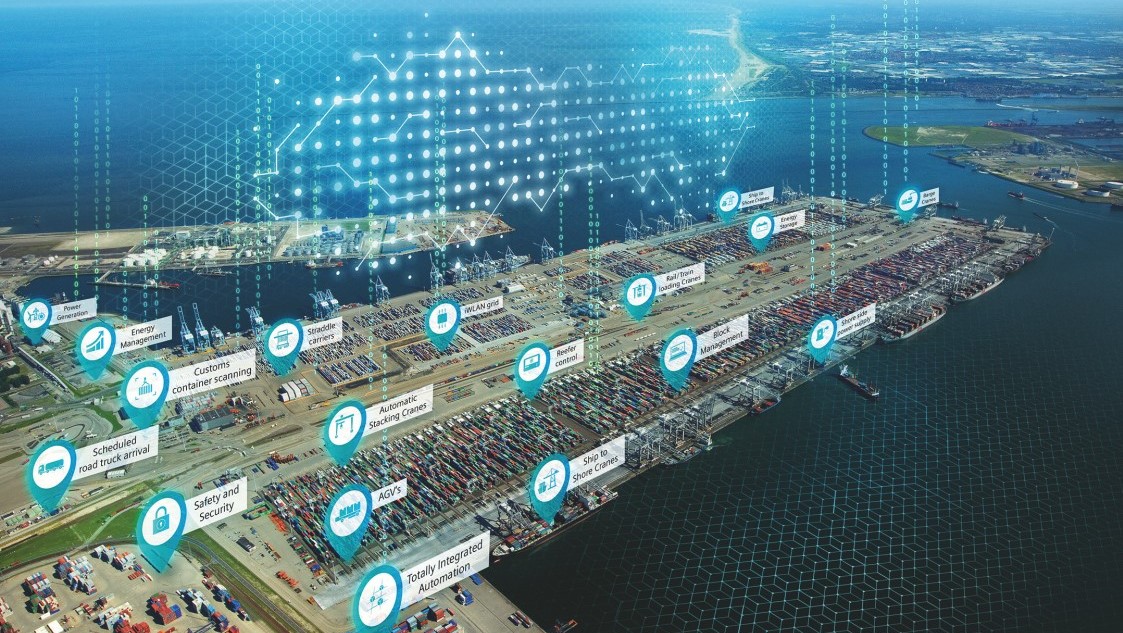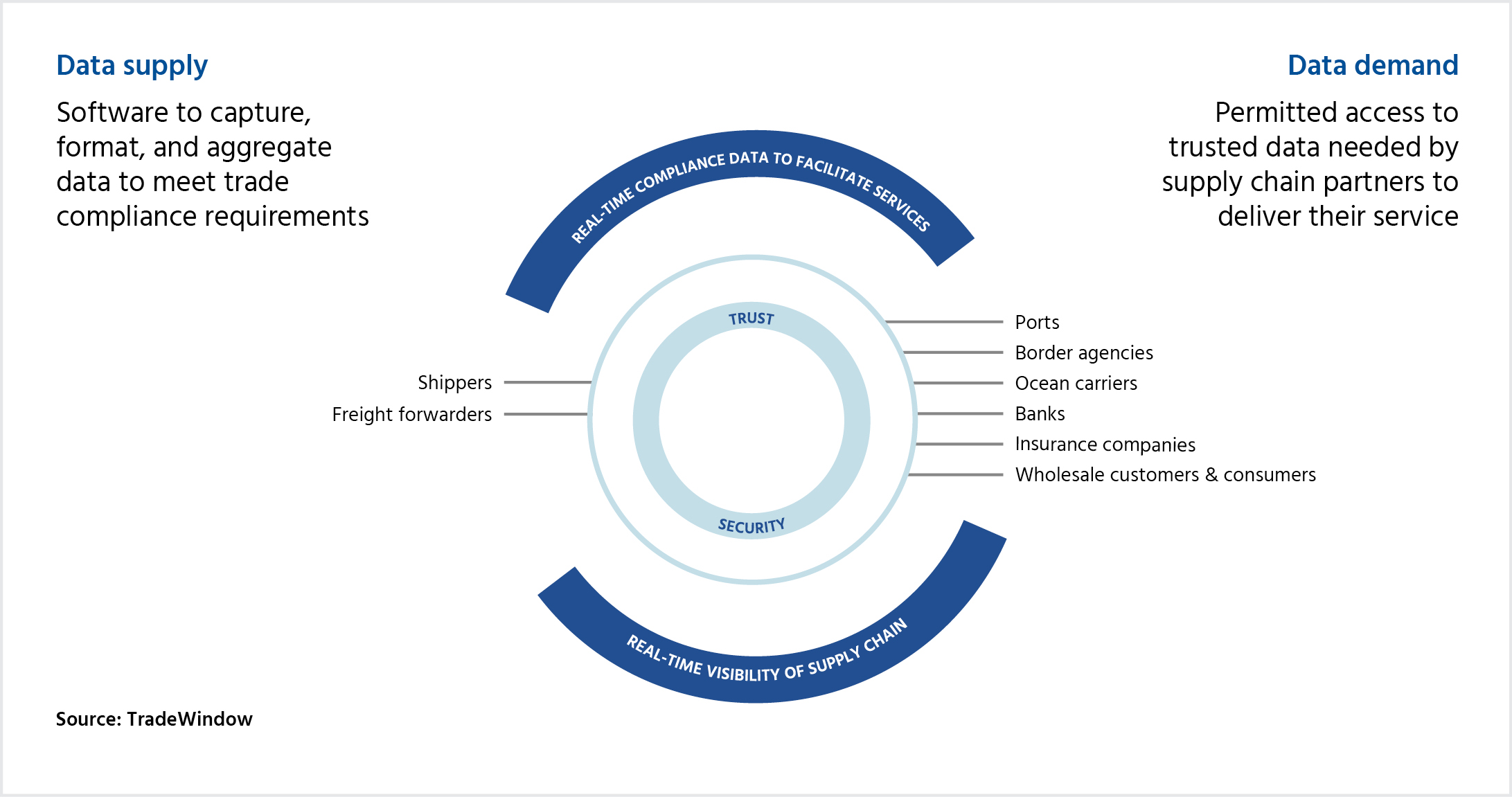Published 07 March 2023
To date, several of the attempts to digitize trade have fallen short because each software platform has only tended to focus on a narrow slice of the entire trade process. An end-to-end sector neutral approach would fully capture and equitably distribute the economic benefits from digital trade facilitation, and make international trade more inclusive for small businesses.
International trade is the lifeblood of the world economy with over US$22 trillion in cross-border transactions each year. Sustainable and inclusive trade can provide prosperity to every economy by fueling economic growth, supporting good jobs, and raising living standards. It has been evident for some time that we need a step change in the way international trade is facilitated.
Even in this age of rapid technological progress you may be surprised to learn that international trade is still largely conducted using manual paper-based processes. Disconnected systems at each stage of the trade process spanning procurement, packing, compliance, logistics, border clearance and payment relies on people entering and re-entering data.
This is no small task. Global consulting firm Boston Consulting Group reports that “a single transaction often requires the interaction of more than 20 entities and involves between 10 and 20 paper documents and 5,000 data field exchanges”. Information needs to be shared not only between the buyers and sellers (“shippers”), but also the logistics providers, banks, insurance companies, and border agencies.
What is digital trade facilitation?
Digital trade facilitation is the digitization of trade information and automation of all the steps involved. The desired result is seamless coordination and data sharing across the supply chain ecosystem. Shippers who’ve already adopted end-to-end digital trade platforms are reporting increased efficiency in their trade process and reduced trade costs. The Asian Development Bank reports that the adoption of full digital trade facilitation could cut average trade costs by more than 13%.[1]
Digital trade platforms significantly reduce the amount of time needed to capture, format, and share data with key supply chain partners. Faster and more accurate processing of trade documents leads to quicker turnaround for cargo and reduced costs throughout the process. The New Zealand Institute of Economic Research estimates that, for the 21 economies of the Asia-Pacific Economic Cooperation trade group, the widespread adoption of digital trade facilitation can realize between US$6 billion and US$12 billion in economic benefits over the next 10 years in the form of:
- Connectivity gains: increases the ease of further connections as trade and participation rates increase.
- Productivity gains: digital trade fundamentally reorganises how businesses, governments, and other supply chain participants approach their trade.
- Visibility (transparency) gains: having one source of authenticity for trade documents cuts down confusion and increases transparency for parties coordinating activities across the supply chain.
- Predictability gains: digital trade generates more data at lower costs. This data can be utilised to better predict demand for specific products.
- Inclusiveness gains: breaking down trading complexities will encourage more firms into trading.[2]
To date, several of the attempts to digitise trade have fallen short because each software platform has only tended to focus on a narrow slice of the entire trade process. For instance, ocean carriers and banks alike have invested millions in digital trade platforms that create little value for shippers and other supply chain participants. A 2018 report by Bain & Company, a global consultancy firm, calls these sector specific platforms ‘digital islands’ – systems that deliver small efficiency gains for the owners’ process but do not connect to other platforms, with manual paper-based processes serving as a bridge between each island. The parochial nature of these platforms has proven to be a barrier to widespread adoption and will benefit from trade facilitation reforms.
In contrast, we need an end-to-end sector neutral approach to fully capture and equitably distribute the economic benefits from digital trade facilitation. These sector-neutral platforms which can connect all players across supply chains are beginning to emerge. They exist solely to facilitate the secure sharing of information between permissioned parties by integrating with the existing systems. These platforms play the role of ‘super connectors’ – trusted parties that serve as a bridge between the siloed commercial, logistics, finance, and government systems that characterize global supply chains. In essence, they create a ‘network of networks’ to seamlessly share data across sectors and regions.
Sector neutrality can correct the imbalance in bargaining power
Sector neutrality is a critical element to help overcome the imbalance of bargaining power between shippers and their larger supply chain partners. We can illustrate this imbalance of bargaining power by thinking of the interaction between shippers (and the freight forwarders who act as their agents) and their supply chain partners including ocean carriers, border agencies, ports, insurance companies, and banks as akin to a marketplace for trade data, as shown below.
The supply side of the market is highly fragmented, with the vast majority of shippers having little bargaining power to influence prices and most commercial terms imposed by their larger supply chain partners on the demand side of the market. We’ve seen the adverse impact of this imbalance over the past few years with ocean carriers reducing supply, increasing prices, and racking up record profits.
Against this backdrop, we’ve seen ocean carriers roll out their own digital trade facilitation platforms. While the technology underpinning these platforms appears to be sound, they lack the economic incentives for shippers to adopt them en masse. It’s entirely rational for shippers to question the merits of adopting a platform owned by an ocean carrier. With such a glaring asymmetry of bargaining power, it would be fair to assume that a digital trade facilitation platform owned and run by such a carrier would tilt the market further in their favor.
Widespread adoption of digital trade facilitation requires a key ingredient to be added – trust. Shippers need to trust that the platform is not just a new channel to market by an ocean carrier. Rather, the platform exists solely to process trade documents faster and more accurately, and provide a single source of verifiable authenticity for all permitted participants in the supply chain ecosystem to coordinate their activities.
Sector-neutral digital trade platforms make international trade more inclusive
The vast majority of international trade is conducted by large enterprises. This is understandable given the economies of scale needed to overcome the cost barriers to international trade (including market research and product development, establishing distribution networks, complying with different regulatory frameworks, and absorbing the financial risks, while maintaining trade competitiveness). In a highly competitive environment, small to medium-sized enterprises (“SMEs”) have to navigate the constraints of limited human resources, information, and capital. SMEs are also often classified as high-risk and are required to comply with additional documentation and checks.
The opportunity for SMEs to leverage digital trade facilitation is significant. Within the economies of the Organisation for Economic Co-operation and Development, SMEs account for 95% of firms, around 67% of total employment, and more than 50% of economic activity. However, their contribution to exports is significantly lower, ranging between 20% to 40% for most economies.
A sector-neutral approach to digital trade facilitation can make international trade more inclusive by lowering the direct costs of trade. These platforms can deliver a more efficient way to prepare trade documents, interact with border agencies, and coordinate with key supply chain partners including ocean carriers and banks. Digitising and simplifying the process end-to-end can shave 20 to 30%[3] off the exporter’s shipping costs. Even modest cost reductions can lead to increased trade.
SMEs are more sensitive to financial and efficiency costs than are large enterprises. The larger the scale of international trade within a firm, the more economies of scale and comparative advantage exist for logistics and export administration.
Productivity is materially higher among exporters. This comes down to the fact that exporting involves significant fixed costs that only larger and already more productive firms can overcome. However, it is also because exporting helps firms become more productive by providing access to a larger market. This allows them to exploit economies of scale, provides them with greater exposure to competitive pressures, global knowledge and skills, and facilitates greater access to investment.
Stronger participation by SMEs in global markets creates virtuous cycles of opportunities. SMEs can use international trade to scale up, enhance productivity, accelerate innovation, and maintain trade competitiveness, which goes hand in hand with higher productivity, an important driver of employment growth.
End-to-end digital trade facilitation can increase connectivity, productivity, visibility, inclusiveness, and can more equitably distribute the economic benefits of trade. These outcomes are best achieved through a sector-neutral approach, where super-connector platforms unify the siloed systems used across the supply chain ecosystem. By providing a trusted means to exchange data, a sector-neutral digital trade platform can streamline and automate international trade to reduce costs and increase the speed of trade for all parties in the supply chain ecosystem.
Sector neutral digital trade facilitation has the potential to make international trade more inclusive for SMEs, by providing them with the tools and resources they need to participate more fully in the global economy. By helping SMEs access new markets, customers, and reduce the costs and complexity of cross-border trade, digital trade facilitation can promote economic growth, innovation, and support the overall competitiveness of the global economy.
***
[1] https://seads.adb.org/news/asean-makes-good-progress-reducing-trade-costs-says-un-survey
[2] Digital trade is the way forward for New Zealand: A preliminary assessment of the costs and benefits of digital trade – November 2021 by Chris Nixon, NZIER.
[3] Revolutionizing World Trade: How Disruptive Technologies Open Opportunities for All by Kati Suominen.
© The Hinrich Foundation. See our website Terms and conditions for our copyright and reprint policy. All statements of fact and the views, conclusions and recommendations expressed in this publication are the sole responsibility of the author(s).







